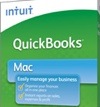QuickBooks from Intuit (http://QuickBooks.intuit.com/product/accounting-software/pro-mac-business-accounting-software.jsp) is the industry standard for financial management. Even if you don’t use QuickBooks, your accountant probably does and you’ll find the widest range of support and services when you use QuickBooks to run your business.
It is, as they say, the 800-pound gorilla you have to deal with in the financial world. When people are considering making the switch from PC to Mac, being able to transfer their QuickBooks information is a key concern. Every year, Intuit promises more compatibility with the Windows version of QuickBooks and promises to bring more of the Windows features to the Mac platform.
Unfortunately, Intuit woefully under-delivers on their promise. The last time I considered using QuickBooks on the Mac was 2006. Back then it wasn’t compatible with my bank or my credit card company, yet the Windows counterpart was. Like many other Mac users, I run QuickBooks on my Mac via a Windows virtual machine. Not having to boot up Windows every time I want to enter invoices would be a welcome change. All said and done, I’m still going to have to keep Windows on my Mac … sigh.
According to Intuit, the key “new” feature of QuickBooks 2010 (US$159.95) compared to previous versions is the ability to accept credit cards directly from within QuickBooks using Intuit’s merchant services solution. If you already do this on the PC, then the switch will be easy. Otherwise, you need to set up an account with Intuit, which may have higher rates then you get from your bank. Another new feature is a setup guide and wizard, but most people would probably use an accountant or bookkeeper for such things, so this feature is of limited value.
The good news for QuickBooks 2010 is that it accurately talks with my credit card company to download information. Additionally, while it did import the raw data correctly from my PC QuickBooks 2008, it did not important my custom reports nor my custom invoices that I paid my accountant to create. In spite of the claimed “improved” compatibility with the Windows counterpart QuickBooks for the Mac failed to deliver.
To be fair, Intuit claims that I should be running QuickBooks 2010 for Windows, and I would have seen more reports transfer over. On a practical level, if you already paid for QuickBooks 2010 for the PC, you are much less likely to switch to a Mac.
Additionally, contact syncing with the address book simply didn’t work at all. Tech support was most unhelpful, but did seem to indicate that if you already have contacts in your address book, QuickBooks isn’t smart enough to figure out to merge the contact info. This is important because most people using QuickBooks likely already have their customers as contacts in their Mac address book.
Typical of QuickBooks is the inclusion of a variety of glitches, crashes and anomalies Mac users have come to expect from an Intuit product. I waited to do the review hoping that each new update to the program would fix some of these problems. With each update, some bugs were fixed while others were introduced. I’ve always been wary of QuickBooks updates since the famous debacle in December of 2007 where an update destroyed the desktop files of unsuspecting Mac users.
if you are starting as a new business, the wizards will help get you off to a good start. New users won’t have to worry about importing from Windows and won’t encounter the transfer problems with older versions. Existing Mac or Windows QuickBooks users will find little value in upgrading to this newer version and should save their money for something else.
Pros: The most Mac compatible version of QuickBooks to date
Cons: Not reliable and inconsistent compatibility and feature parity with PC version.
Rating 6 out of 10
— “Doctor Dave” Greenbaum


